Fire & Regret: Contragolpe para os arqueiros
Olá! Pessoal, hoje aqui no @dreloop07 falaremos mais aprofundado a respeito da regra “Fire & Regret” do game @splinterlands, que promete ser uma boa armadilha para as cartas de ataque “ranged”, despertando boas oportunidades de pensar estrategicamente.
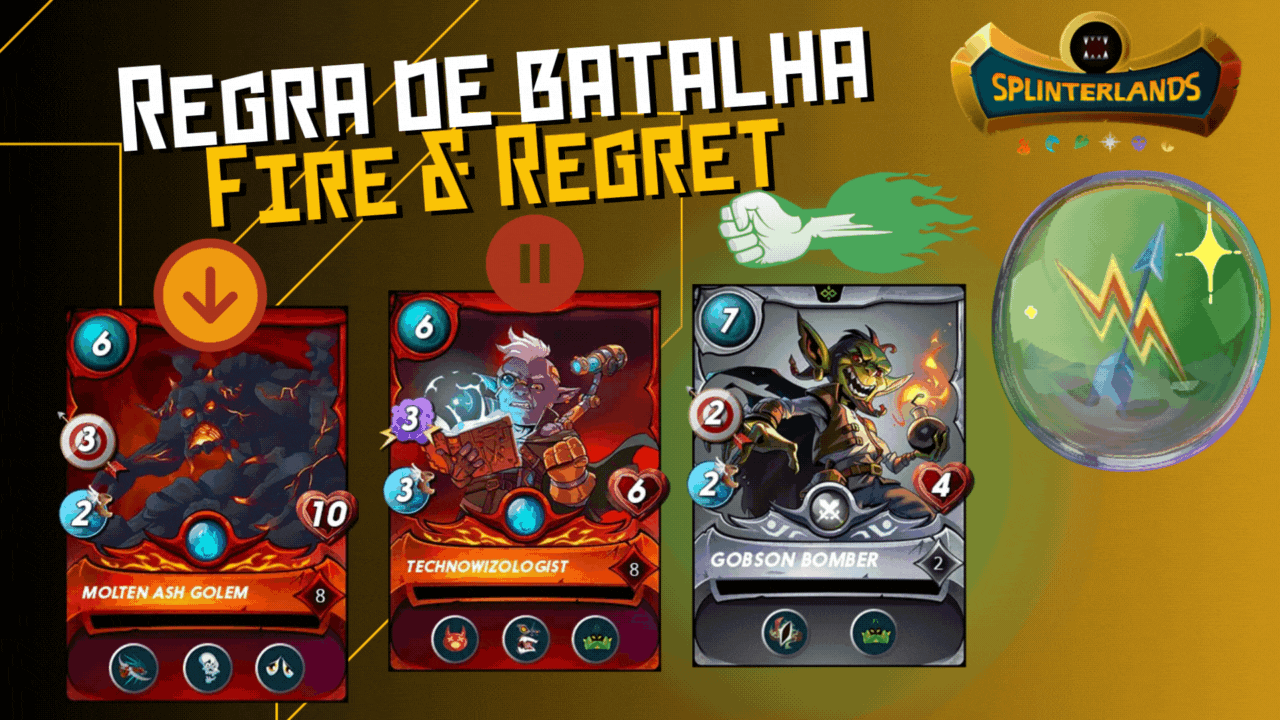
| This publication was also writen in PORTUGUESE and ENGLISH . |
|---|
 Hello this post is a onboard introduction project from BR audience, ENGLISH VERSION AT THE END. Hello this post is a onboard introduction project from BR audience, ENGLISH VERSION AT THE END. |
Primeiramente, devemos ter mente que você e seu adversário vão estar nessa situação em que as cartas de ataque “ranged” são prejudicadas com essa armadilha de contragolpe. Como vimos anteriormente, nem sempre a melhor oportunidade, estar em evitar esse tipo de carta.
| Simbolo | Regra | efeito |
|---|---|---|
| Fire & Regret | todas as unidades recebem a habilidade “Return Fire” no início da batalha. Unidades inimigas que atacam com ataques à distância recebem dano de volta. |
Devemos também observar a interação que as habilidades das cartas “Ranged” tem na partida, sobretudo com relação de influência quando essa regra estiver vigente no campo de batalha. Logicamente, as cartas arqueiras com habilidade “Reflection Shield” são exemplos mais claro, de se utilizar cartas “Ranged” sem dano de contragolpe. Por outro, possui cartas com habilidade “Amplify” pode aumentar os danos de contragolpe trazendo mais ofensividade, mesmo assim ainda é algo que não faze efeito numa carta arqueira com “Reflection Shield”.
Habilidades uteis:
Agora falando de algumas habilidades de cartas que tem uma maior conectividade, conseguir listar algumas: A "amplify" acredito que seja principal em termos de ofensividade, além de estar presente em invocadores, o que possibilitar usar seu efeito de forma mais abrangente. Já falando em termos defensivos temos a "Reflection Shield" , talvez seja melhor forma de possui uma carta "ranged" mesmo com essa regra. O "Redemption" considero uma última carta antes de perde sua carta "ranged".
| Amplify | Reflection Shield | Redemption |
|---|---|---|
 |  |  |
| aumenta o dano a unidades mágicas, de longo alcance e corpo a corpo, respectivamente. | Unidades com Escudo Reflexo não sofrem danos de Fire & Regret. Se você se enquadra neste conjunto de regras, incluir uma unidade "ranged" com Escudo de Reflexão pode fornecer a vantagem necessária para vencer! | Dependendo da sua estratégia, você pode optar por sacrificar sua Unidade com resgate antecipado para colher a recompensa de +1 de dano ao seu oponente. Esses conjuntos de regras são ideais para tal ação. |
Outra muito importante que necessita dessa regra para fazer efeito é a “Marty”. Outra importante em aspecto ofensivo é a “Recharge” mais necessário ter alguns cuidados ao utilizar esse tipo de habilidade nessa regra, Acredito que se uma carta com essa habilidade possui também "Camouflage" , posicionando-a em posições mais recuadas só poderá levar o contragolpe da "Fire & Regret".
| Martyr | Recharge | Weaken |
|---|---|---|
 |  |  |
| qualquer conjunto de regras que ajude a acelerar sua unidade com mártir em direção à morte será unidade, adjacentes. | Certifique-se de que sua unidade recarregada possa receber o que eles distribuem! Embora atacar em rodadas alternadas possa ser benéfico aqui, considere as possibilidades antes de incluir uma unidade com recarga em sua escalação. | Certifique-se de que suas unidades de ataque à distância possam aguentar o que elas oferecem! |
Por último o “Weaken” que ajudar dar alguma dianteira na partida, reduzindo a saúde das cartas adversarias, mas é bom fica atento as característica defensiva da carta que a possui. Então é sempre bom ter alguns cuidados antes de considerar uma carta “ranged” na sua estratégia com uma regra como essa.
Estratégia de batalha:
Agora! Pensando em estratégia nas condições da regra “Fire & Regret”. Me deparei com uma partida na qual possui 53 de mana disponível, na qual não possuia dos decks: Vida, Dragão e Morte.
| Mana | regra | decks inativos |
|---|---|---|
 |  |  |
Nessas condições, só podia contar com três decks para essa partida, embora os decks da água e terra sejam melhor em uso de cartas magicas que é muito tendencioso para essa partida optei pelo do fogo, como forma mais efetiva de me defender desses ataques.
https://splinterlands.com/?p=battle&id=sl_86bb307518bb84c893bc60c236a07975
Como invocador para essa partida escolhi, Qid Yuff leve 8, como o contragolpe dessa armadilha para cartas “ranged” a regra “Fire & Regret” não é de dano direto, uma boa quantidade de armadura em cartas de ataque pode significa alguma forma de proteção dando uma dianteira numa partida equilibrada. Considere usar “Piercing” em todas suas cartas para resolver esse dilema.
| Invocador | Qid Yuff leve 8 |
|---|---|
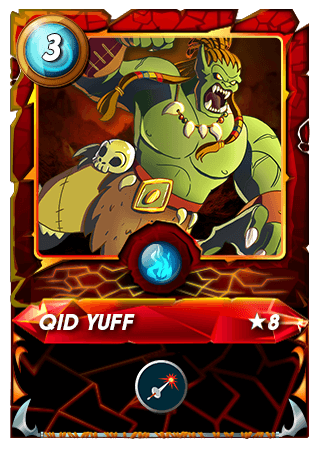 | Invocador raro do deck de fogo com habilidade “Piercing” |
Considerando o ataque tendencioso nesse tipo de regra, uma carta como a “Grum” pode ser muito útil para proteger sua linha de frente, além de ser uma carta que tem a possibilidade de se fortalecer durante a partida se tornando mais ofensivo.
| 1 posição | Grum Flameblade leve 4 |
|---|---|
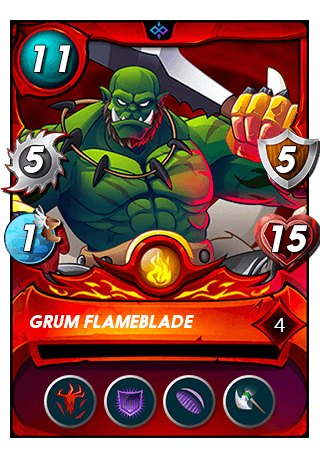 | Carta de ataque “melee” do deck de fogo com hablidades “Bloodlust”, “void armor”, “void” e “Giant Killer” |
Para segunda opção escolhi o “Molten Ash Golem” apesar de ser uma carta arqueira, tem uns combos bem legais nessas condições, pois ela características tem uma boa quantidade de mana, pode ser usada na primeira posição, reduz tanto a saúde como ataque “melee” das cartas adversarias.
| 2 posição | Molten Ash Golem leve 8 |
|---|---|
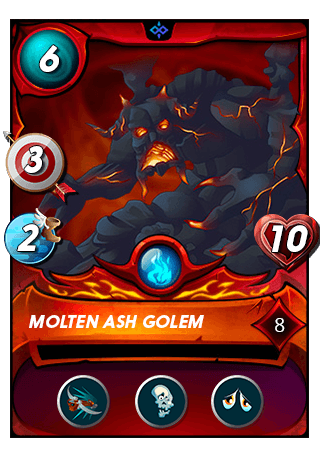 | Carta arqueira com habilidades “Close range”, “Weaken” e “Demoralize” |
Para terceira posição optei pela “Gargoya Devil” esse foi mais uma boa opção de arqueira que tem a possibilidade de atacar posicionado na primeira posição caso necessário. Uma boa carta também no aspecto defensivo.
| 3 posição | Gargoya Devil leve 8 |
|---|---|
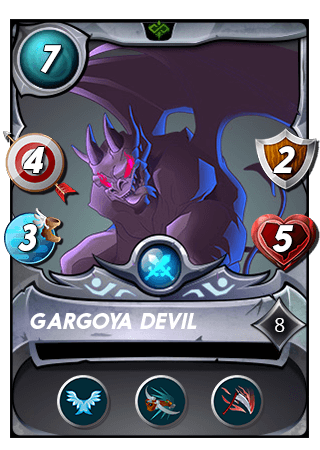 | carta arqueira neutral com habilidades:Flying, Close ranged e Deathblow |
Já na quarta posição a “naga” sobressai como uma boa opção ofensiva e principalmente defensiva contra ataques “sneaks”, pois as minhas duas últimas opções não virão alvo na primeira posição e ela possui armadilha para as cartas de ataque “melee” e redução de dano.
| 4 posição | Naga Fire Wizard leve 8 |
|---|---|
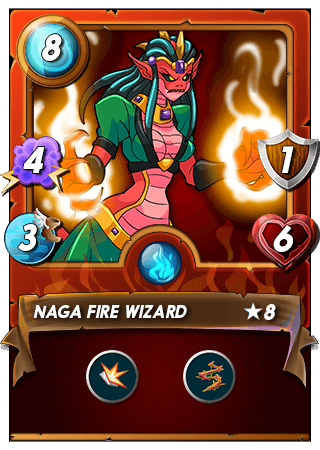 | Carta magica do deck de fogo com habilidades: Shield e Thorns. |
Para quinta posição escolhi a “Technowizologist” outra carta magica interpresante que só vira alvo na primeira posição muito importante para conter os avanços do tanque adversário e ajudar a eliminar uma possível “taunt”.
| 5 posição | Technowizologist leve 8 |
|---|---|
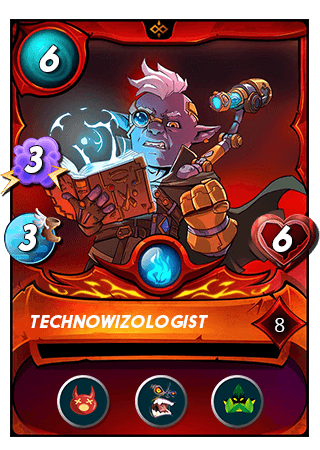 | Carta magica do deck de fogo com habilidades: Stun, Fury e Camouflage |
Para minha última opção a “Gobson” se mostrar muito importante para romper a barreira defensiva na primeira linha adversaria, mesmo sendo uma carta arqueira, nessa posição sua única preocupação é o contragolpe da regra, pois só vira alvo na primeira posição.
| Ultima posição | Gobson Bomber leve 2 |
|---|---|
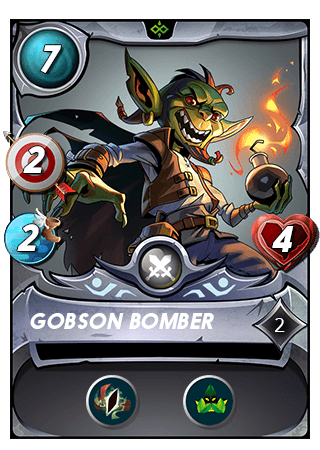 | carta neutral arqueira com habilidades: Camouflage e Recharge |
Às vezes, algumas combinações de habilidades em cartas arqueiras podem ajudar a contornar um pouco os efeitos dessas regras e muitas vezes usar a seu próprio favor, para o sucesso na batalha.
Considerações:
Então! É isso galera, espero que tenham gostados das dicas de hoje para regra “Fire & Regret”. Devido às combinações de habilidades, às vezes as melhores oportunidades, estão justamente nas mãos das cartas arqueiras, que evitamos muitas vezes devido à penalização da regra. Obrigado! Pela apreciação e até a próxima.
ENGLISH VERSION




Hello! Guys, today here at @dreloop07 we will talk in more depth about the “Fire & Regret” rule from the game @splinterlands, which promises to be a good trap for “ranged” attack cards, creating good opportunities to think strategically.

Firstly, we must bear in mind that you and your opponent will be in this situation where the “ranged” attack cards are harmed by this counterattack trap. As we saw previously, the best opportunity is not always to avoid this type of card.
| Symbol | Rule | effect |
|---|---|---|
| Fire & Regret | All units receive the “Return Fire” ability at the start of the battle. Enemy units that attack with ranged attacks receive damage in return. |
We must also observe the interaction that the abilities of the “Ranged” cards have in the match, especially with regard to influence when this rule is in force on the battlefield. Logically, archer cards with the “Reflection Shield” ability are clearer examples of using “Ranged” cards without counterattack damage. On the other hand, having cards with the “Amplify” ability can increase counterattack damage, bringing more offense, even so it is still something that has no effect on an archer card with “Reflection Shield”.
Useful skills:
Now talking about some card abilities that have greater connectivity, I can list a few: I believe "amplify" is the main one in terms of offensiveness, in addition to being present in summoners, which makes it possible to use its effect in a more comprehensive way. Speaking in defensive terms we have the "Reflection Shield", perhaps it is the best way to have a "ranged" card even with this rule. "Redemption" I consider a last card before losing your "ranged" card.
| Amplify | Reflection Shield | Redemption |
|---|---|---|
 |  |  |
| increases damage to magical, ranged, and melee units, respectively. | Units with Reflex Shield do not take damage from Fire & Regret. If you fall under this ruleset, including a ranged unit with Reflection Shield can give you the edge you need to win! | Depending on your strategy, you may choose to sacrifice your Unit with early redemption to reap the reward of +1 damage to your opponent. These rule sets are ideal for such action. |
Another very important one that needs this rule to be effective is “Marty”. Another important offensive aspect is “Recharge”, but it is necessary to be careful when using this type of ability in this rule. I believe that if a card with this ability also has "Camouflage", positioning it in more backward positions can only lead to a counterattack. from "Fire & Regret".
| Martyr | Recharge | Weaken |
|---|---|---|
 |  |  |
| any set of rules that help accelerate your unity with martyr toward death will be unity, adjacent. | Make sure your recharged unit can take what they dish out! While attacking every other round can be beneficial here, consider the possibilities before adding a cooldown unit to your lineup. | Make sure your ranged units can take what they throw at you! |
Finally, the “Weaken” will help give you a head start in the match, reducing the health of the opposing cards, but it is a good idea to pay attention to the defensive characteristics of the card that has it. So it's always good to be careful before considering a “ranged” card in your strategy with a rule like this.
Battle strategy:
Now! Thinking about strategy under the conditions of the “Fire & Regret” rule. I came across a game in which I had 53 mana available, in which I didn't have any of the decks: Life, Dragon and Death.
| Mana | rule | inactive decks |
|---|---|---|
 |  |  |
Under these conditions, I could only count on three decks for this match, although the water and earth decks are better at using magic cards, which is very biased for this match, I opted for the fire deck, as a more effective way to defend myself against these attacks.

https://splinterlands.com/?p=battle&id=sl_86bb307518bb84c893bc60c236a07975
As the summoner for this match I chose Qid Yuff, take 8, as the counterattack of this trap for “ranged” cards, the “Fire & Regret” rule is not direct damage, a good amount of armor on attack cards can mean some form of protection giving a lead in a balanced match. Consider using “Piercing” on all your cards to resolve this dilemma.
| Summoner | Qid Yuff take 8 |
|---|---|
 | Rare fire deck summoner with “Piercing” ability |
Considering the biased attack in this type of rule, a card like “Grum” can be very useful to protect your front line, in addition to being a card that has the possibility of strengthening itself during the game, becoming more offensive.
| 1 position | Grum Flameblade Light 4 |
|---|---|
 | “Melee” attack card from the fire deck with “Bloodlust”, “void armor”, “void” and “Giant Killer” abilities |
For the second option I chose the “Molten Ash Golem” despite being an archer card, it has some really cool combos in these conditions, as its characteristics have a good amount of mana, can be used in the first position, reduces both health and melee attack ” of the opposing cards.
| 2 position | Molten Ash Golem Light 8 |
|---|---|
 | Archer card with “Close range”, “Weaken” and “Demoralize” abilities |
For third position I opted for the “Gargoya Devil” this was another good archer option that has the possibility of attacking positioned in the first position if necessary. A good card also in the defensive aspect.
| 3 position | Gargoya Devil light 8 |
|---|---|
 | neutral archer card with abilities: Flying, Close ranged and Deathblow |
In fourth position, the “naga” stands out as a good offensive and especially defensive option against “sneaks” attacks, as my last two options will not be targeted in the first position and it has a trap for “melee” attack cards and reduction of damage.
| 4 position | Naga Fire Wizard light 8 |
|---|---|
 | Magic card from the fire deck with abilities: Shield and Thorns. |
For fifth position I chose “Technowizologist”, another interplaying magic card that only becomes a target in the first position, very important to contain the advances of the opponent tank and help eliminate a possible “taunt”.
| 5 position | Technowizologist take 8 |
|---|---|
 | Fire deck magic card with abilities: Stun, Fury and Camouflage |
For my last option, “Gobson” proves to be very important to break the defensive barrier in the opponent's first line, even though it is an archer card, in this position your only concern is the counterattack of the rule, as it only becomes a target in the first position.
| Last position | Gobson Lightweight Bomber 2 |
|---|---|
 | neutral archer card with abilities: Camouflage and Recharge |
Sometimes, some combinations of skills on archer cards can help to somewhat circumvent the effects of these rules and often use them to your advantage, for success in battle.
Considerations:
Then! That's it guys, I hope you enjoyed today's tips for the “Fire & Regret” rule. Due to skill combinations, sometimes the best opportunities are in the hands of archer cards, which we often avoid due to the rule penalty. Thanks! For your appreciation and until next time.
Obrigado por promover a Língua Portuguesa em suas postagens.
Vamos seguir fortalecendo a comunidade lusófona dentro da Hive.
Your post was manually curated by @michupa.
Delegate your HP to the hive-br.voter account and earn Hive daily!
🔹 Follow our Curation Trail and don't miss voting! 🔹
Checkout our BDVoter Daily Hive Showcase & Participate into our Daily giveaway to win various prize.
Thanks for sharing! - @mango-juice
